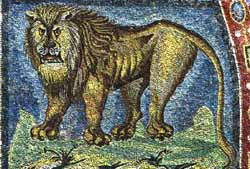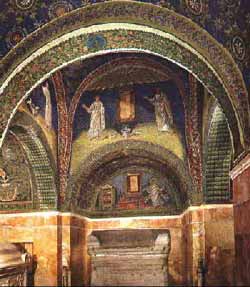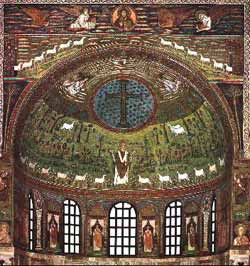
 |

REPORT FROM RAVENNAby Paul Bentley I visited Ravenna for the first time in April 1995, and it really does seem to be true that she is, as she claims, the mosaic capital of the world. First of all there are the famous half-dozen buildings with outstanding early Byzantine mosaics - Galla Placidia and the others. Then there are several colleges that teach mosaic; dozens of mosaic studios and artists; a permanent indoor exhibition of contemporary mosaics, and another in the Park of Peace; occasional exhibitions, festivals and conferences; IRTEC, a research institute, and by no means least, PRO.MO., the organisation for promoting all aspects of Ravenna mosaics, both ancient and modern. Manuela Farneti, a native of the city, whose excellent Glossary of Mosaic Art is reviewed on our book page, works for PRO.MO. and was good enough to show me round.
The first thing you do is inspect the Byzantine mosaics, naturally. And the first thing that strikes you is the luscious brilliance of the gold, which no photograph can do justice to. But then in St. Vitale the intensity and freshness of the colours (especially the greens) of the newly cleaned and restored presbytery arch and adjacent panels are as astonishing as those of the Michelangelo frescoes in the Sistine. Cesare Fiori, who does mosaic research for IRTEC, kindly gave me a copy of the superbly detailed and illustrated report on the restoration of the arch (Restauri ai Mosaici nella Basilica di S. Vitale a Ravenna - L'arco presbiteriale, by C. Fiori and C. Muscolino, pub. Consiglio Nazionale Delle Richerche, Istituto di Ricerche Tecnologiche per la Ceramica, i.e. CNR IRTEC). Work continues on the rest of the St. Vitale presbytery, and also in St. Apollinare Nuovo, and in the Orthodox Baptistery, where Riccardo Bissi was persuaded by Ms. Farneti to pause for a while to answer my questions. What was he working on at the moment? Stabilizing tesserae. One thinks of glass tesserae as virtually indestructible, but this is not always so. You may recall the case of the Holy Souls chapel in Westminster Cathedral (MM7), and in the Baptistery Mr. Bissi is having to deal with deterioration of the smalti colours, apparently brought about by humidity from the many tourists, causing salts to dissolve out of the tesserae, so that they act like sponges. In fact nowadays the number of visitors at any one time is restricted. I raised the perennial chestnut of exactly how the Byzantines made their mosaics. We know they made sinopie (preliminary sketches) on the brickwork. Did they use painting on the top layer of plaster, the setting bed, in Ravenna? Si. When Mr. Bissi restored Ravenna wall mosaics in the early fifties he found evidence of full colour underpainting on the setting beds in Galla Placidia and St. Vitale. He believes the Byzantines always used colour underpainting before inserting tesserae. Interestingly, there were occasional second thoughts as regards the design - in St. Apollinare in Classe peacock sinopie have been found under mosaic sheep - but there's no evidence of pentimenti, i.e. adjusting the actual tesserae once they had been inserted. The Byzantines were highly skilled masters of their art.
Three hues of gold leaf were used, on variously coloured glass bases, and these tesserae were placed in a red setting bed in Vitale, and in green elsewhere. The gold pieces were occasionally reversed for special effects, but the 'black dots' we see in the gold ground were not planned, the leaf has simply flaked off over the centuries. One of the mysteries is that no-one has ever found evidence of a giornata (the amount of damp plaster you can mosaic in a day). Michelangelo's giornate in the Sistine ceiling frescoes varied from one square metre to two, as we can tell from the seams between them, and they remained workable for some eight hours. But there are no visible seams in our Ravenna mosaics, only holes for the scaffolding. Also there is no difference in the level of the plaster, which you would expect to find if a new area was laid each day. This argues that the giornate were very large by our standards, and were kept damp and workable for a long period, perhaps even months. The sheer depth of the plaster (up to 3 inches thick) would retain moisture for a good while, and the Byzantines may well have added organic substances to the plaster to keep it workable for as long as they needed. (Cesare Fiori and Franca Donati of IRTEC provide an analysis of the plaster used in St. Vitale in the Restauri ai Mosaici book mentioned above. Incidentally, Dr. Fiori is currently analyzing the plaster and brickwork of the exterior of Galla Placidia.) On the question of whether the Byzantines used the reverse method, Mr. Bissi is sure they didn't. It is true that faces are flatter than the gold ground, but that is because they inevitably demanded particular, detailed, care. He has never found evidence of the very thin 'buttered' layer of plaster used in the reverse technique, and the tesserae are in fact in narrower underneath, and close-fitting at the top. Mr. Bissi teaches at the School of Mosaic Restoration in Ravenna . However, restoration is not confined to the mosaics of the city. He recently worked on a floor mosaic in Turin, and was one of those involved in working on the 'Sea Medallion', part of a floor mosaic from the sixth century Apostles Church in Madaba, Jordan, which in 1992 was sent to the School of Mosaic Restoration for cleaning and renovation. This was one of the first fruits of an agreement between Italy and Jordan in 1990, aimed at conserving Jordan's many mosaics (mainly Byzantine floor mosaics), and setting up a school of mosaic restoration there. Some Jordanians have been trained by the Ravenna School so that they can work on mosaics in their own country. Again, I was given a copy of the detailed, fully illustrated report - Il Restauro del Medaglione del Mare dalla Chiesa dei Ss. Apostoli in Madaba, Giordania, ed. A.M. Iannucci et al, pub. CNR IRTEC 1992, which is volume 3 of IRTEC's Mosaico e Restauro Musivo series.
I also acquired Mosaico: scuole, ateliers, vetrerie - Ravenna meets St. Petersburg, by Isotta Fiorentini. Prompted by the conference of the International Association of Contemporary Mosaic in St. Petersburg in 1992 , this invaluable volume starts by giving details of institutes that teach mosaic, in Brazil, the Ivory Coast, Egypt, Japan, France, Greece, Romania, Russia and of course Italy. It then lists 140 mosaic artists and studios, with over 30 from Ravenna, and includes 34 colour photos of mosaics by contemporary artists. A section on manufacturers of glass tesserae follows (I was surprised to learn that smalti are made in France, and also in Moscow and St. Petersburg); and finally there are summaries of various papers given at the 1992 AIMC conference. Mainly in Italian with some French and English, the book costs 40,000 lira, and is published by Longo Editore, Via Paolo Costa 33, 48100 Ravenna; tel and fax +544 217 026. Longo also publish Ms. Farneti's Glossary of Mosaic, and other works, such as Mosaici a S. Vitale e altri restauri, the proceedings of the 1990 national conference held in Ravenna on the restoration of wall mosaics (pp 295, 90,000 lira). Alternatively, ask about these and other mosaic books at the following bookshop - Libreria Modernissima, 48100 Ravenna, Via C. Ricci 35 (tel +544 213 894). Pausing only to buy a couple of mosaicist's hammers (one for smalti, one for stone) from an ironmonger's in the town, we concluded my tour with a call on the Cooperativa Mosaicisti, a flourishing studio formed in 1948. Paul Zanotti, a Scot who is working at the Co-op, told me about their latest piece, a large wall mosaic (18m x 4.10m) in marble, smalti and gold. Commissioned by Shalom Mayer Tower Ltd. of Tel Aviv, the cartoon was designed by David Sharir. They were making it by using a version of double reverse, which gives a mosaic with a variable surface. They lay down damp lime plaster as a temporary setting bed, and keep it moist. Having done the mosaic direct into this bed, they then stick sacking on top with soluble glue and pull the mosaic off the lime plaster. Having removed any plaster still on the tesserae, they stick the mosaic onto the actual base, a board (about an inch thick) which is a sandwich of aluminium and fibre glass, strong and lightweight, originally developed for aircraft. A distinct improvement on concrete, though expensive. The mosaic is of course cut into jigsaw pieces before being installed. As ever, I was interested in cost. For a marble mosaic they charge around 2 million lira per sq. metre (c. £725); and for smalti work anything from 3 to 5 million lira per sq. metre (c. £1085 to £1800), depending as ever on the amount of cutting involved and the type of smalti used. If you want to know more about Ravenna and mosaic contact PRO.MO. at - c/o CNR IRTEC, Via Fiandrini s.n., 48100 Ravenna, tel +544 343 69. Tourist Information is at Via Salara 8, tel +544 35404, fax 35094. MM7:In the Holy Souls Chapel, on the other hand,, Deborah Carthy of Conservation Specialists of Haslemere, Surrey, came up against a most unusual problem - a glass disease. The mosaic was applied direct, in 1902/3. The background was not the usual gold but ‘silver’ - in fact platinum was used, to avoid tarnishing. When the tesserae were viewed at close quarters prior to cleaning it turned out that the glass had crazed, the thick layer under the platinum being the worse affected. No literature was available on the subject but happily, after consultation with Dr. Norman Tennent of Strathclyde University, who is an expert on glass and ceramics, it proved possible to consolidate the glass. Dr. Tennent also analysed the setting bed, which is mastic - a mixture of whiting, beeswax and linseed oil.[Back to text] |
All
content is copyright of © Mosaic Matters and its contributors.
All rights reserved
Mosaic
Matters is:
Editor: Paul Bentley
Web Manager/Designer: Andy Mitchell



